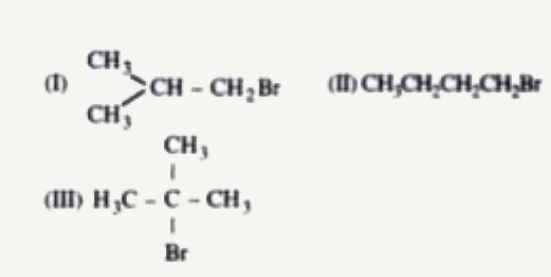Arrange the following in increasing order of boiling point: n-butane,n-butanol,n-butylchloride, iso-butane.
To arrange the compounds n-butane, n-butanol, n-butyl chloride, and isobutane in increasing order of boiling point, we need to consider the factors that affect boiling points, such as molecular structure, branching, and intermolecular forces.
1. Identify the Compounds:
- n-butane (C4H10): A straight-chain alkane.
- n-butanol (C4H10O): A straight-chain alcohol.
- n-butyl chloride (C4H9Cl): A straight-chain alkyl halide.
- isobutane (C4H10): A branched alkane.
2. Analyze the Molecular Structures:
- n-butane and isobutane are both alkanes. However, isobutane has a branched structure, which generally leads to lower boiling points due to reduced surface area.
- n-butanol has an -OH group, which allows for hydrogen bonding, significantly increasing its boiling point compared to alkanes.
- n-butyl chloride has a polar C-Cl bond, which also contributes to its boiling point, but not as significantly as hydrogen bonding in alcohols.
3. Consider the Effects of Branching:
- Isobutane has more branching than n-butane, leading to a lower boiling point for isobutane.
- n-butane has a higher boiling point than isobutane due to its straight-chain structure.
4. Rank the Compounds:
- Based on the analysis:
- Isobutane (lowest boiling point due to high branching)
- n-butane (higher boiling point than isobutane)
- n-butyl chloride (higher boiling point than n-butane due to polarity)
- n-butanol (highest boiling point due to hydrogen bonding)
5. Final Order:
- The increasing order of boiling points is:
1. Isobutane
2. n-butane
3. n-butyl chloride
4. n-butanol
Final Answer:
Isobutane < n-butane < n-butyl chloride < n-butanol
- n-butane (C4H10): A straight-chain alkane.
- n-butanol (C4H10O): A straight-chain alcohol.
- n-butyl chloride (C4H9Cl): A straight-chain alkyl halide.
- isobutane (C4H10): A branched alkane.
- n-butane and isobutane are both alkanes. However, isobutane has a branched structure, which generally leads to lower boiling points due to reduced surface area.
- n-butanol has an -OH group, which allows for hydrogen bonding, significantly increasing its boiling point compared to alkanes.
- n-butyl chloride has a polar C-Cl bond, which also contributes to its boiling point, but not as significantly as hydrogen bonding in alcohols.
- Isobutane has more branching than n-butane, leading to a lower boiling point for isobutane.
- n-butane has a higher boiling point than isobutane due to its straight-chain structure.
- Based on the analysis:
- Isobutane (lowest boiling point due to high branching)
- n-butane (higher boiling point than isobutane)
- n-butyl chloride (higher boiling point than n-butane due to polarity)
- n-butanol (highest boiling point due to hydrogen bonding)
- The increasing order of boiling points is:
1. Isobutane
2. n-butane
3. n-butyl chloride
4. n-butanol
Isobutane < n-butane < n-butyl chloride < n-butanol
Topper's Solved these Questions
- ALCOHOLS, PHENOLS & ETHERS Book:VMC MODULES ENGLISHChapter:ALCOHOLS, PHENOLS & ETHERS Exercise:Example
Explore 20 Videos
- ALCOHOLS, PHENOLS & ETHERS Book:VMC MODULES ENGLISHChapter:ALCOHOLS, PHENOLS & ETHERS Exercise:PRACTICE EXERCISE:1
Explore 21 Videos
- 13-14 HYDROGEN & S-BLOCK ELEMENTBook:VMC MODULES ENGLISHChapter:13-14 HYDROGEN & S-BLOCK ELEMENTExercise:JEE Advanced Archive
Explore 48 Videos
- ALCOHOLS, PHENOLS & ETHERSBook:VMC MODULES ENGLISHChapter:ALCOHOLS, PHENOLS & ETHERSExercise:Impeccable
Explore 100 Videos
Similar Questions
Knowledge Check
Arrange the following compounds in increasing order of boiling point :
Prpane-1-ol, butan-1-ol, butan-2-ol, pentan-1-olAPropan-1- ol, butan -1-ol, butan-1-ol, pentan -1-olBPentan-1-ol,butan-2-ol, butan-1-ol,propan -1-olCPentan-1-ol,butan- 2- ol, butan -1-ol, propan-1-olDPentan-1-ol,butan-1-ol, butan-2-ol,propan-1-olArrange the following compounds in increasing order of boiling point :
Prpane-1-ol, butan-1-ol, butan-2-ol, pentan-1-olAPropan-1- ol, butan -1-ol, butan-1-ol, pentan -1-olBPentan-1-ol,butan-2-ol, butan-1-ol,propan -1-olCPentan-1-ol,butan- 2- ol, butan -1-ol, propan-1-olDPentan-1-ol,butan-1-ol, butan-2-ol,propan-1-ol
Arrange the following compounds in increasing order of their boiling points
View SolutionArrange the following compounds in increasing order of their boiling points.

View SolutionArrange the following in the decreasing order of their boiling points:
(i) n-Butyl chloride (ii) Isobutyl chloride (iii) ter-Butyl chloride.
View SolutionArrange the following compounds in increasing order of boiling point :
Prpane-1-ol, butan-1-ol, butan-2-ol, pentan-1-ol
View Solution(a) How will you distinguish between the following pairs of compounds:
(i) Aniline and Ethanamine
(ii) Aniline and N-methylaniline
(b) Arrange the following compounds in decreasing order of their boiling point: Butanol, Butanamine, Butanone
View SolutionArrange the following in decreasing order of their boiling points.
(A). N-butane
(B). 2-methylbutane
(C). N-pentane
(D). 2,2-dimethylpropane
View Solution
